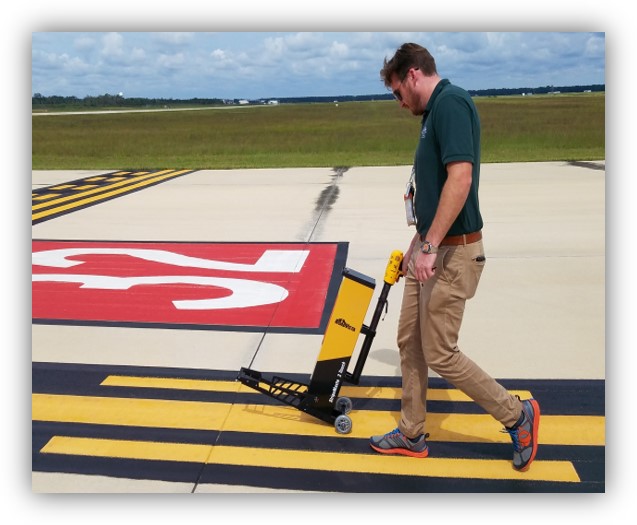AFM Assessment
It’s been about two years since we began expanding our pavement marking knowledge and experience into the airfield environment. It has been an excitingly, fast-paced learning curve for us here at PPP. Fortunately, with our near three decades in the roadway pavement marking industry, we were able to catch on quickly. However, we could not have done so without the help of many. This help included the kind folks at the Jacksonville Aviation Authority, especially the airfield management and maintenance team. They not only assisted us in learning the basics, like what an enhanced taxiway centerlineis, but also gave us their airfield to practice, learn, and assess, honing our skills and knowledge of the airfield. We also appreciate our relationship with Sightline. These guys know their stuff when it comes to airfield markings. We don’t always agree, as you might have caught in our last combined presentation, but I appreciate and respect their experience and expertise tremendously.

We at PPP are continually striving to create Safe, Smart, Simple Solutions for transportation safety. In part, this is why we think it is so important to use high-tech RoadVista retroreflectometers for safe, smart, simple marking assessments. With the newly set airfield marking retroreflectivity requirements by the FAA, it is now more critical than ever that the airfield management team maintains a marking assessment program. Depending on the airport’s size, talent, and budget, this program may be managed and undertaken in-house, managed with outside sources or both. In my relatively short experience with airports, but vast experience in markings assessment, I would humbly make the following suggestions:
- For Small to Mid-size airports, I suggest a little of both. With a quality handheld retroreflectometer and proper assessment training, the airfield maintenance team should conduct the routine inspection and contractor quality assurance. However, our case study exercise identified that for these airports, the more complex airfield wide assessment may call for the professionals. Yes, this is coming from the guy that benefits by selling more mobile retroreflectivity units (MRU).
- For Large-size airports with more resources like budget and staffing, there may be a more significant benefit in owning and operating their own MRU for these assessments. The busier large-size airports may need multiple airfield wide assessments annually or find that working around airfield schedules may make contracting impracticable.
- Another idea from the roadway industry is partnering up with other airports in the purchase and management of the MRU. We sometimes have Metropolitan or Transportation Planning Organizations purchase an MRU to be shared among the cities and counties within their organization.
Keeping with the Safe, Smart, Simple goal in mind, we recently completed a three-part Airfield Marking Assessment Quick Reference Guide. Our goal is to enhance the references and tools already out there like the outstanding Airfield Marking Handbook . Part one is the basics of Proper Inspection, part two is the basics of the Specifications, and part three is the basics of Evaluation. These were built on an “infographic” design in an attempt to provide more understandable and comprehensive information with brevity. This guide is useful for either in-house or contract marking assessment. Download the Airfield Marking Assessment Quick Reference Guide Part 1 here. If you wish to be notified of the release of Part 2 and Part 3, be sure to click here on our Friends List to be the first to receive it and other useful tools.
I am excited about PPP’s future in the airfield industry. We will continue to build on our existing pavement marking experience with these new airfield experiences, ultimately making transportation safe from our roadways to our runways!
Sincerely,
Greg Driskell
President, PPP, Inc.
Safe, Smart, Simple Transportation Safety Innovators


